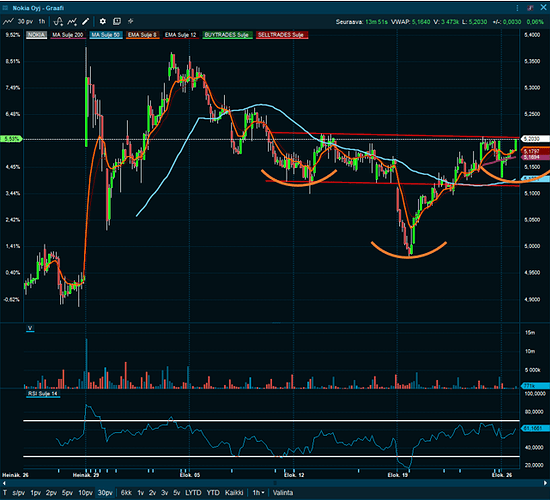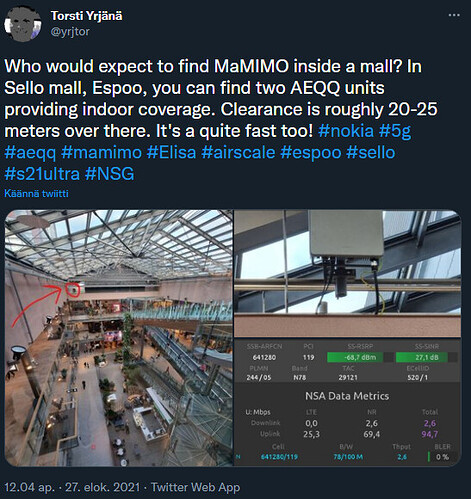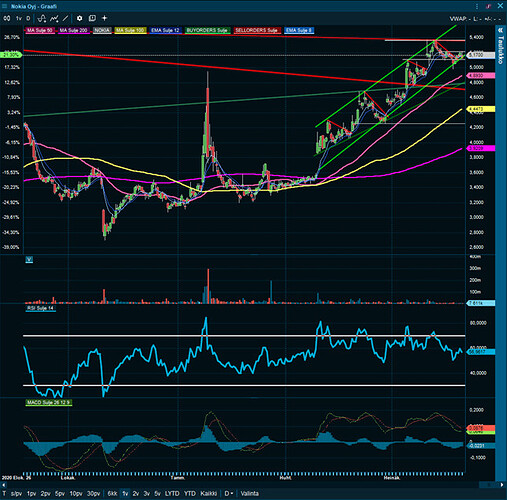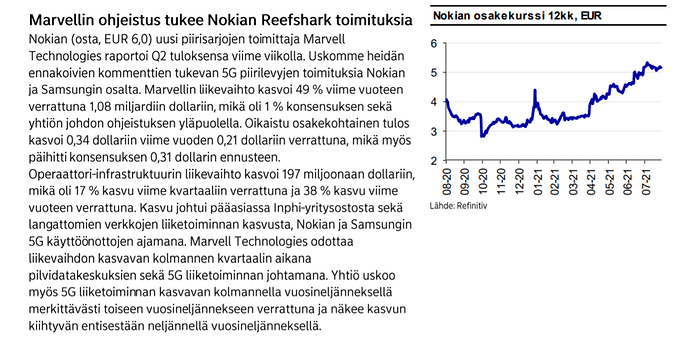Päivitys. Breakout vai ei?
Lisätietoa T-Mon vuotoon liittyen. En todellakaan ole tämän asiantuntija, mutta vaikutaisi T-Mobilen sisäiseltä ongelmalta ja ettei liitosta ole Nokiaan tai Ericssoniin. Joku kenties osaa ottaa paremmin kantaa?
T-Mobile Hacker Who Stole Data on 50 Million Customers: ‘Their Security Is Awful’
By Drew FitzGerald and Robert McMillan
The hacker who is taking responsibility for breaking into T-Mobile US Inc.'s systems said the wireless company’s lax security eased his path into a cache of records with personal details on more than 50 million people and counting.
John Binns, a 21-year-old American who moved to Turkey a few years ago, told The Wall Street Journal he was behind the security breach. Mr. Binns, who since 2017 has used several online aliases, communicated with the Journal in Telegram messages from an account that discussed details of the hack before they were widely known.
The August intrusion was the latest in a string of high-profile breaches at U.S. companies that have allowed thieves to walk away with troves of personal details on consumers. A booming industry of cybersecurity consultants, software suppliers and incident-response teams have so far failed to turn the tide against hackers and identity thieves who fuel their businesses by tapping these deep reservoirs of stolen corporate data.
The breach is the third major customer data leak that T-Mobile has disclosed in the past two years. The Bellevue, Wash., company is the second-largest U.S. mobile carrier with roughly 90 million cellphones connecting to its networks.
The Seattle office of the Federal Bureau of Investigation is investigating the T-Mobile hack, according to a person familiar with the matter. “The FBI is aware of the incident and does not have any additional information at this time,” the Seattle office said in a statement Wednesday.
In messages with the Journal, Mr. Binns said he managed to pierce T-Mobile’s defenses after discovering in July an unprotected router exposed on the internet. He said he had been scanning T-Mobile’s known internet addresses for weak spots using a simple tool available to the public.
The young hacker said he did it to gain attention. “Generating noise was one goal,” he wrote. He declined to say whether he had sold any of the stolen data or whether he was paid to breach T-Mobile.
Several cybersecurity experts said the public details of the hack and reports of previous T-Mobile breaches show the carrier’s defenses need improvement. Many of the records reported stolen were from prospective clients or former customers long gone. “That to me does not sound like good data management practices,” said Glenn Gerstell, a former general counsel for the National Security Agency.
Mr. Binns said he used that entry point to hack into the cellphone carrier’s data center outside East Wenatchee, Wash., where stored credentials allowed him to access more than 100 servers.
“I was panicking because I had access to something big,” he wrote. “Their security is awful.”
He said it took about a week to burrow into the servers that contained personal data about the carrier’s tens of millions of former and current customers, adding that the hack lifted troves of data around Aug. 4.
On Aug. 13, the security research firm Unit221B LLC reported to T-Mobile that an account was attempting to sell T-Mobile customer data, according to the security firm. Two days later, T-Mobile publicly acknowledged it was investigating a potential breach.
T-Mobile confirmed that more than 50 million customer records have been stolen. The wireless carrier said it had repaired the security hole that enabled the breach. “We are confident that we have closed off the access and egress points the bad actor used in the attack,” it said in a statement. A T-Mobile spokeswoman declined to comment on specific claims by Mr. Binns or by cybersecurity experts.
For Mr. Binns, who uses the online names IRDev and v0rtex, among others, the T-Mobile hack represents a major development in a track record that has featured various exploits and – four years ago – peripheral involvement in the creation of a massive network of hacked devices that was used for online attacks.
Mr. Binns showed the Journal that he could access accounts linked to the IRDev online personality, which shared screenshots depicting access into T-Mobile’s network. He declined to be photographed but answered personal questions to confirm his identity as John Binns.
In a statement, Unit221B said it believed the individual behind the IRDev alias was responsible for the T-Mobile hack because someone using this handle was reaching out to online criminals trying to sell the T-Mobile data before the hack had been made public.
It’s unclear whether Mr. Binns worked alone. At one point in his communications with the Journal, he described a collaborative effort to find the login credentials needed to crack T-Mobile’s internal databases. Another online personality also offered in online forums to sell some of the stolen T-Mobile data.
Mr. Binns said he grew up in northern Virginia with his Turkish mother. His father died in 2002 when Mr. Binns was two years old, according to a newspaper article and a published obituary.
He attended McLean High School in 2015 and 2016, according to the school’s yearbooks. He was estranged from his father’s family and moved with his mother to Izmir, Turkey, shortly after his 18th birthday, according to a person familiar with the matter.
He contacted a U.S. relative last year, claiming by telephone that he was a computer expert who had been kidnapped and taken to a hospital against his will, this person said. “He gushed about how he could do anything with a computer,” this person said.
In Telegram messages with the Journal, Mr. Binns repeated similar claims. He said he wanted to draw attention to his perceived persecution by U.S. government authorities. He described an alleged incident in which he claims he was abducted in Germany and put into a fake mental hospital.
“I have no reason to make up a fake kidnapping story and I’m hoping that someone within the FBI leaks information about that,” he wrote, explaining his reason for publicly discussing the hack.
Mr. Binns’s mother didn’t respond to phone calls and messages seeking comment. After the Journal reached out to her for comment, she took down her public Facebook page.
In 2020, Mr. Binns sued the Central Intelligence Agency, Federal Bureau of Investigation and other federal agencies to compel them to fulfill a federal records request he made for information about FBI investigations of botnet attacks. He didn’t use an attorney to file the complaint in the case, which is still active in the U.S. District Court for the District of Columbia. The agencies have denied his allegations in past court filings.
Security researchers said several online profiles tied to Mr. Binns were associated with groups of young gamers who have infected swarms of devices around the world. These botnets, as the infected device clusters are called, are often used by other gamers to knock people and websites offline.
Mike Benjamin, vice president of security for network operator Lumen Technologies Inc., said U.S. prosecutions in past years have limited the threat from these botnets, though network attacks have started growing in recent months. He said many young people, especially in the U.S. and Europe, first learn basic hacking techniques by sharing tricks and tactics with fellow gamers online.
“Online videogaming drives a natural competitiveness,” Mr. Benjamin said. “Everybody’s looking for that edge. That can reach into this area of outside of the videogame,” where tactics end up “breaking the internet instead of just inside the rules of the game.”
Mr. Binns told the Journal he first learned to find zero-days – previously undisclosed software flaws – by figuring out cheats for videogames such as “Minecraft,” “Arma” and “DayZ.” He said he found the zero-day that other hackers used to create Satori, a botnet-building virus that infects unprotected home routers, but denied writing any of the Satori code.
“There are people who are way more skilled than I am,” he wrote.
The August hack of T-Mobile stole an array of personal details from more than 54 million customers, according to the company’s latest tally. Some customers had their names, Social Security numbers and birth dates exposed. Another batch of data included IMEI and IMSI numbers tied to users’ phones, which other attackers could use as a starting point to take control of victims’ phone lines.
T-Mobile last week started notifying affected customers. The company offered two years of identity-protection services and reminded customers to regularly update passwords and PIN codes as a standard precaution.
The carrier has suffered other data breaches before. The company notified customers of two separate breaches in 2020 that affected smaller sets of records. The company this year hired McDonald’s Corp. executive Timothy Youngblood to oversee its cybersecurity measures. He succeeded longtime information security chief Bill Boni, who retired in June.
The Federal Communications Commission said it has launched a probe into the latest failure.
Past data-breach penalties have reached into the hundreds of millions of dollars. Equifax Inc. in 2019 reached a settlement with U.S. officials to resolve several investigations and lawsuits for $700 million. The credit-data provider generated $3.5 billion of revenue that year. T-Mobile had $68.4 billion of revenue in 2020.
A 2020 merger with Sprint Corp. made T-Mobile the U.S.'s second-largest mobile service provider, trailing only Verizon Communications Inc. T-Mobile executives have said they intend to keep growing by luring subscribers away from the competition.
“The upside for them from here is moving upmarket,” said New Street Research analyst Jonathan Chaplin. “For the high-end customers that might’ve thought about moving over, this might be a signal that ‘Hey, T-Mobile isn’t Verizon yet.’ This is totally unquantifiable, but to the extent that there’s brand damage, that’s where it will be felt.”
Write to Drew FitzGerald at andrew.fitzgerald@wsj.com and Robert McMillan at Robert.Mcmillan@wsj.com
Onko tilanne sama dollaripohjaisessa kuviossa?
Siellä en ainakaan itse havaitse nykyisellä tasolla. Päivätasolla olisi erilailla piirrettävissä, mutta siellä lienee ongelmana tuo lähtökohta. IHS kuviota etsitään ennen kaikkea silloin kun on ollut laskua takana. Mutta joka tapauksessa NOK 6,10 USD tienoo antaa sen verran paljon koskutuksia että olettaisin tuolla olevan jonkin verran merkitystä.
Euromääräisesti piirtämäni kuvio meni siinä mielessä metsään että breikkasi kyllä, mutta myyntiaalto kumosi sen käytännössä samantien. Eli se siitä. ![]()
Elisa on alkanut täyttää sisätiloja Nokian airscalella. Taajuus ilmeisesti n78, eli 3500 MHz. Keskitaajuutta siis käytetään, kun Suomessa ei taida olla viellä mmwave kaupallisessa käytössä.
5G FIXED WIRELESS RIDES PANDEMIC-RELATED SHIFT
Fixed wireless access will be among the most valuable use cases for 5G network operators, according to new reports that predict compound annual growth rates in excess of 70%. ABI Research and Mobile Experts forecast that 5G fixed wireless access connections will increase at a compound annual growth rate of 71% and “over 70%,” respectively. ABI Research expects global 5G fixed wireless access to exceed 58 million residential households by 2026, and Mobile Experts predicts 5G fixed wireless access to serve 66.5 million customers by 2026. Fixed wireless access is a decades-old technology, but its prominence and rate of growth grew substantially during the last year amid the ongoing COVID-19 pandemic, which has forced billions of people worldwide to stay home. Mobile Experts projects the number of global fixed wireless access connections will more than double to 190 million by 2026.
“LTE (4G) will be the dominant technology of choice for larger mobile operators in developing regions, constituting about 60% to 80% of fixed wireless access connections,” Kyung Min, principal analyst at Mobile Experts, wrote in a report. “Meanwhile, 5G fixed wireless access connections will grow the fastest and will represent 35% of all fixed wireless access connections in 2026,” Mun explained, adding that he expects fixed wireless access to serve nearly 100 million customers by the end of this year. https://www.sdxcentral.com/articles/news/5g-fixed-wireless-rides-pandemic-related-shift/2021/08/
Viikko 34 – Viikon tärkeimmät Nokia -uutiset ja asiat
Omat subjektiiviset näkemykseni, myös arvioiden uutisen merkitsevyyden.
Merkittävän hyvä uutinen ![]()
Ei yksittäisenä uutisena erityisen merkittävä ![]()
Merkittävän huono uutinen ![]()
Viikon tärkeimmät uutiset:
![]() Nokia sai laajennussopimuksen Itävallan A1 operaattorilta. Nokia ja Ericsson jakavat 5G projekteja Bulgariassa, Kroatiassa, Serbiassa sekä Sloveniassa – Itävallassa Nokia on aiempien sopimusten perusteella ainoa toimittaja. Nokia sai RAN-sopimuksen Bulgariaan sekä Serbiaan ja Sloveniaan RAN ja core -sopimukset. Nokian osuus on Ericssonia suurempi, ja kokonaisuutena sopimus on luultavasti kohtuullisen kokoinen. Bulgarian sopimus pitää luultavasti sisällään Huawein laitteiden vaihtamisen. Nokian tiedote
Nokia sai laajennussopimuksen Itävallan A1 operaattorilta. Nokia ja Ericsson jakavat 5G projekteja Bulgariassa, Kroatiassa, Serbiassa sekä Sloveniassa – Itävallassa Nokia on aiempien sopimusten perusteella ainoa toimittaja. Nokia sai RAN-sopimuksen Bulgariaan sekä Serbiaan ja Sloveniaan RAN ja core -sopimukset. Nokian osuus on Ericssonia suurempi, ja kokonaisuutena sopimus on luultavasti kohtuullisen kokoinen. Bulgarian sopimus pitää luultavasti sisällään Huawein laitteiden vaihtamisen. Nokian tiedote
![]() Walesin Ogi on valinnut Nokian partnerikseen päivittämään kiinteää verkkoaan. Yhtiö on ilmoittanut 200 miljoonan punnan investoinneista ja tavoitteesta uudistaa verkkoa 150 000 asunnon osalta vuoteen 2025 mennessä. Lähde
Walesin Ogi on valinnut Nokian partnerikseen päivittämään kiinteää verkkoaan. Yhtiö on ilmoittanut 200 miljoonan punnan investoinneista ja tavoitteesta uudistaa verkkoa 150 000 asunnon osalta vuoteen 2025 mennessä. Lähde
![]() Yhdysvaltalainen Union Wireless valitsi Nokian uudeksi langattoman verkon toimittajakseen osana ”Rip and Replace” -ohjelmaa, joka on suunnattu pienille yhdysvaltalaisille operaattoreille. Aiemmin verkon rakensi Huawei. Nokian tiedote
Yhdysvaltalainen Union Wireless valitsi Nokian uudeksi langattoman verkon toimittajakseen osana ”Rip and Replace” -ohjelmaa, joka on suunnattu pienille yhdysvaltalaisille operaattoreille. Aiemmin verkon rakensi Huawei. Nokian tiedote
![]() Tutkimuslaitos Dell’Oro on nostanut RAN-markkinnan (radio access network) kasvuennusteita vuodelle 2021. Nyt odotuksena on 10-15 %:n kokonaiskasvu. Lähde
Tutkimuslaitos Dell’Oro on nostanut RAN-markkinnan (radio access network) kasvuennusteita vuodelle 2021. Nyt odotuksena on 10-15 %:n kokonaiskasvu. Lähde
![]() Chippien saatavuudessa on ongelmia, ja tiettävästi myös hinnat ovat nousussa. TSMC on nimettömien lähteiden (asiasta uutisoitu twitterissä ja esimerkiksi Digitimesissä) mukaan nostamassa mm. 7 nm ja 5 nm tuotannon hintoja 10 %:lla vuodesta 2022 eteenpäin. Nokia oletettavasti altistuu näille hintojen nousulle sekä Marvellin että Broadcomin kautta. Voisi olettaa, että myös Intelillä on halukkuutta hintojen nostoon, mutta saako Nokia jonkinlaista alennusta menneiden vuosien ongelmista johtuen?
Chippien saatavuudessa on ongelmia, ja tiettävästi myös hinnat ovat nousussa. TSMC on nimettömien lähteiden (asiasta uutisoitu twitterissä ja esimerkiksi Digitimesissä) mukaan nostamassa mm. 7 nm ja 5 nm tuotannon hintoja 10 %:lla vuodesta 2022 eteenpäin. Nokia oletettavasti altistuu näille hintojen nousulle sekä Marvellin että Broadcomin kautta. Voisi olettaa, että myös Intelillä on halukkuutta hintojen nostoon, mutta saako Nokia jonkinlaista alennusta menneiden vuosien ongelmista johtuen?
![]() Kiinan operaattoreiden (China Mobile, China Telecom ja China Unicom) 5G rakentaminen oli alkuvuonna huomattavasti ennakoitua hiljaisempaa LightReadingin uutisoinnin perusteella. Tilanteesta syytetään puolijohdevalmistajien chippipulaa, mutta onko esimerkiksi Huaweilta loppuvat chippivarastot yhdistettynä ostokieltoon vähintään osittainen syy. Loppuvuonna kyseisillä operaattereilla on tarkoitus kiihdyttää merkittävästi investointeja – saavatko Nokia ja Ericsson jatkossa lisäosuutta rakentamisesta? Lähde
Kiinan operaattoreiden (China Mobile, China Telecom ja China Unicom) 5G rakentaminen oli alkuvuonna huomattavasti ennakoitua hiljaisempaa LightReadingin uutisoinnin perusteella. Tilanteesta syytetään puolijohdevalmistajien chippipulaa, mutta onko esimerkiksi Huaweilta loppuvat chippivarastot yhdistettynä ostokieltoon vähintään osittainen syy. Loppuvuonna kyseisillä operaattereilla on tarkoitus kiihdyttää merkittävästi investointeja – saavatko Nokia ja Ericsson jatkossa lisäosuutta rakentamisesta? Lähde
Muita viikon otsikoita:
Nokia subsidiary discloses data breach after Conti ransomware attack
Ericsson CEO warns China will be ‘formidable’ if 5G or 6G splits
SA announced as location for National 5G Industrial Incubation Lab
Tipranks News sentiment:
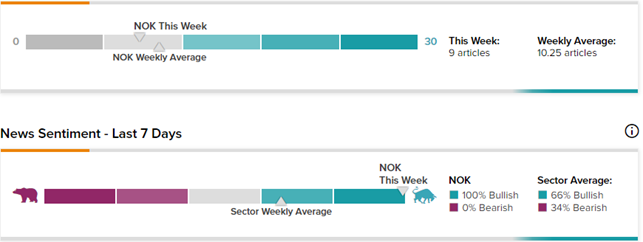
Melkolailla hiljaista edelleen uutisvirran pysytellessä odottavana. Viikon ainoa hieman merkittävämpi uutinen oli laajennussopimus A1 kanssa. Se uutinen oli siis myönteinen Nokian kannalta.
Viikkokehitys suhteessa Ericssoniin:
Nokia (+2,2 %) jäi pitkästä aikaan jalkoihin suhteessa Ericssoniin (+5,9 %) viikkotuotoissa. Viime viikon viestissä kirjoittelin, että Ericssonin osake on pyrkinyt muodostamaan pohjia 98 kruunuun - signaalia mahdolliselle trendimuutokselle antoi nouseva RSI trendi ja laskevat kurssipohjat. Ericssonilla oli merkittävää laskua takana, joten Nokiaa parempi viikkotuotto selittyy tällä, tuki ponnistukselle löytyi.
Tekninen kuva:
Pitkä trendi on muuttumaton. Vastusalueena toimii noin 5,35-5,38 € , ja seuraavana noin 5,60-5,75 € (01/2019 huiput). Näiden alueiden haastamista odotellessa.
04/2021 alkanut nousutrendi on ollut hyvin vahva. Jos se säilyisi voimissaan, olisi vuoden lopussa osakekurssi noin 6,8-7,2 €:n välillä. Onkohan tämä kuitenkin liian optimistinen vielä tämän vuoden tavoitteeksi? Nyt viime pörssipäivät on kulutettu tämän trendin lattiaa.
Vahvan nousun jälkeen elokuun pienehköllä vaihdolla osake on vetänyt happea, ja ollut sivuttaisliikkeessä. Tänään osake pyrkii säilymään 04/2021 alkaneella nousutrendillä – 5,085 € on pohjasta pohjaan piirretyn linjavedon mukainen hinta tälle päivälle. Edellinen low on 4,9805 €.
50 päivän MA 4,89 - yläpuolella
200 päivän MA 3,92 € - yläpuolella
50 viikon MA 3,82 € - yläpuolella
200 viikon MA 4,22 € - yläpuolella (myös tämä liukuva keskiarvo on kääntynyt nousevaksi)
Mukavaa perjantaita!
Eikö tämä voisi olla aika merkittävä uutinen Nokian mobiiliverkkoja ajatellen? Q2-raportissa kohdemarkkinoiden kasvuoletusta nostettin 3 prosentista 6 prosenttiin, mutta olisikohan nyt lisäkorotukselle aineksia?
Voisi tosiaan kyseinen uutinen mennä merkittävän hyvän uutisen puolelle.
Nokia siis informoi asiasta tällä tavoin Q2 yhteydessä:
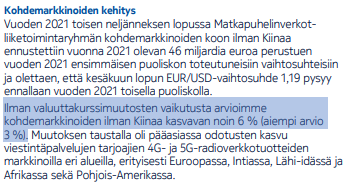
Eli ilman Kiinaa odottavat kohdemarkkinan nousevan 6 %. Kiinalaisten operaattorien mukaan markkina kasvaisi poikkeuksellisen kovasti Kiinassa H2/2021. Selittyisikö tällä Nokian erilainen (mutta mahdollisesti linjassa oleva) näkemys Dell’Oron raporttiin nähden, vai onko Nokia edelleen liian konservatiivinen arviossaan? Toki loppuvuoden aikana edelleen negatiivisena tekijänä on Verizonen 5G työmaa… ääh kun tätä ei enää haluaisi mainita.
Ehkei tämä ole niin paha, miltä tuntuu. Jos Nokia saa myytyä kaikki uudet ReefShark-sirut, mitä ehditään valmistaa, Verizon-tappio ei siten vaikuttaisi isosti vuonna 2021. Tulevina vuosina kun tuotanto on saatu ajettua ylös 100 prosenttiin toimituksista, olisi kiva, jos saisi myytyä myös Verizonelle.
Q2-konffapuhelussa oli näistä markkinan kasvuluvuista puhetta. Tässä ote transcriptista:
Marco Wiren – Chief Financial Officer
"Thank you, Pekka, and good morning, everyone, from my side as well. I will now provide some more detail on our financial performance in the second quarter. As Pekka already mentioned, we continue to benefit from strengthening end markets. We have also increased our forecast for our addressable market in 2021 and we now estimate that the total addressable market will grow by 5% in constant currency in 2021.
And this is up from the previous estimate of 3%. And the increase has primarily been driven by Mobile Networks where we have seen rising investments in 5G. Note also that our forecast for mobile RAN growth in U.S. dollars would be consistent with the estimates for 2021 from third parties just like Dell’Oro."
Eli Nokian arviot olleet linjassa Dell’Oron kanssa, joita nyt nostettiin 10 %:sta 10-15 %:iin. Markkinan myötätuuli näyttää siis puhaltavan suotuisasti myös loppuvuodesta.
Marvell on pistänyt luvut tiskiin, kasvu kovaa ja kovempi meno jatkuu yhden yrityskaupankin tukemana
Kauppaa saatu 5nm teknologiaan, valmistus TSMC. Nokia ja Samsung mainittu. TSMC:n kuten aiemmin palstalla todettu kerrotaan nostavan kehittyneiden chippien hintoja 10% 2022, Marvell kertoo hoitavansa homman neutraaliksi kannaltaan asiakkaiden kanssa.
→ riskiä ja kohoavia kustannuksia Nokialle. Toivottavasti reagointi on mahdollista kustannusten suhteen. Sinänsä koska puolet toimituksista on kallista non-Reefsharkkia., kustannustaso voi laskea. Mutta mikä kustannustaso mielessä kauppoja on solmittu onkin toinen juttu
Marvell, accordingly, watched its sales grow 32% for the recent July-ending quarter, to about $1.08 billion, compared with the year-earlier period. The figures were undoubtedly buoyed by its $10 billion takeover of Inphi, a data center specialist, earlier this year. But Murphy insists much of the improvement was organic. He expects it to continue, as well. For its current third quarter, Marvell is guiding for a 53% increase in revenues, to $1.145 billion.
The dependency of Marvell on TSMC is a worry. Asked on the analyst call to explain Marvell’s recent successes in the market for application-specific integrated circuits (ASICs), Murphy said they were "all leveraging … the five-nanometer technology platform that we’ve introduced in the summer of 2020." If Marvell cannot procure these components from TSMC or South Korea’s Samsung – the only other chipmaker that currently appears capable of producing them – it will have to let down its own customers.
In the telecom arena, they include major network vendors such as Nokia and Samsung, both of which Murphy mentioned on the call. “Our wireless revenue growth was driven by ongoing deployments of 5G as well as product ramps at Samsung and Nokia," he said. "Design win progress continues in 5G, and I am pleased to report that we have won a next-generation ASIC design leveraging our five-nanometer technology platform within the radio unit at a key basestation customer.”
Even if Marvell can avoid falling short, chip prices are going up. Citing sources close to the matter, the Wall Street Journal this week reported that TSMC is poised to raise the prices of its most advanced chips by about 10% and charge 20% more for less sophisticated components. “I anticipate as we head into calendar 2022 that there will be additional increases across the industry and input costs,” said Murphy when quizzed about the pricing environment. “And I’m confident, as part of Marvell, we’re able to work with our customers to neutralize that impact.”
https://www.lightreading.com/5g/marvell-loss-widens-as-chip-costs-look-set-to-rise/d/d-id/771752?
Osakesäästöohjelmissa tavallinenkin työntekijä voi säästää osan palkastaan esim. Max 5% (en muista Nokian lukuja), joilla hänelle ostetaan Q-tuloksen julkaisun jälkeen osakkeita sillä rahalla jonka hän on säästänyt. Ja sen jälkeen on sovittu että työntekijän on pidettävä osaketta esim 2 vuotta jonka jälkeen yhtiö antaa 2 osaketta vastaan 1 yhden tai 3 vastaan yhden. Tällä on tarkoitus sekä sitouttaa sekä palkita henkilökuntaa, sillä et he toimivat myös omistajina yhtiössä jossa työskentelävät. Ja osakkeen arvon noustessa kappalemäärät tulevat laskemaan mitä tähän järjestelyyn menee, koska työntekijät saavat säästösummallaan kappalemääräisesti osakkeita vähemmin. Ja Nokian osake on tiettävästi tässä noussut. Että ennyt olisi juuri huolissaan mistään osakesäästöohjelmista. Olisin paremminkin tyytyväinen, että Nokian työntekijät ovat laittaneet omaa rahaa myös kiinni yhtiöön.
Nyt kuuluu erikoisen kummallisia maailmalta.
Finnish telecoms equipment maker Nokia suspended its work in a key industry group due to fears that it could face U.S. penalties for working with Chinese technology firms on Washington’s blacklist.
Nokia informed a group called the O-RAN Alliance that “we have no choice but to suspend all of our technical work activities” in the group because of a “compliance-related matter … regarding the O-RAN contributors included in the U.S. entity list,” according to an email seen by POLITICO.
Vähän vastaavaa tapausta sivusta seuranneena työn puolesta voin sanoa että näistä voimme kiittää lakimiehiä ja sitä että nuo jenkkien entity list lait on kirjoitettu niin että niitä voidaan tulkita eri tavoin ja koska tiedämme että jos juttu päätyy niin pitkälle että joku raapustaa oikeusjutun jenkeissä (tai vielä pahempaa, jenkkien hallinto sellaisen raapustaa) niin kalliiksi tulee, ihan sama mikä on lopputulos. Joten firmojen lakimiehet ottavat mielummin konservatiivisesti jarrua jos on vähänkään epäselvää ja sitten odotellaan regulaattorin lupaa / ennakkotapausta.
AI on edge processing tulee olemaan se iso business, ei niinkään AI-algoritmien kehitykseen käytettävät supertietokoneet, joissa NVIDIA on ollut yksi edelläkävijöistä ja mm. Teslalle big data algoritmikehityksen laitetoimittaja. Se onko NVIDIA vahva edge tuotteiden AI-piiriteknologiassa on hieman kysymysmerkki, mutta ainakin ARMilla on AI-aplikaatiopiirisarjoja jo nyt tarjolla. Koko AI piirikehityskenttä on laaja ja pirstaleinen. AI on muotijuttu nyt ja kaikki kerätystä big datasta analysoimalla kehitetyt algoritmiaplikaatiot on AIita. Nokiankin suuntaavia antenneja markkinoidaan AI suuntaavina ![]() Serveri- ja verkonhallintasoftalla kehuvat AIn ansiosta optimoineensa asiakkaiden verkkoja ja datavirtoja.
Serveri- ja verkonhallintasoftalla kehuvat AIn ansiosta optimoineensa asiakkaiden verkkoja ja datavirtoja.
5G verkkoja, edge prosessointia ja AIita ei voi erottaa toisistaan. 5G verkko mahdollistaa AIn soveltamisen päätelaitteissa, koska lyhyen latenssin ansiosta AI prosessointi voidaan keskittää verkon reunalla olevalle serverille tai pienessä määrin jopa basebandiin.
Kauppailmoitus viikon aloitukseen.
Press Release
Nokia and Indosat Mega Media bring smart Wi - Fi for improved broadband experience in Indonesia
- Nokia WiFi mesh allows Indosat Mega Media to provide a superior broadband experience to its subscribers with improved speed and coverage
- Nokia is Indosat Mega Media’s preferred partner for providing world-class Wi-Fi solution to its home and enterprise subscribers
30 August 2021
Jakarta, Indonesia – Nokia today announced that Indosat Mega Media (IndosatM2) , a subsidiary of Indosat , is using Nokia WiFi m esh solution to provide an improved broadband experience to its home and enterprise customers across the country. The solution, including Nokia WiFi Beacon device s , allows Indosat M2 to provide comprehensive coverage throughout the premises .
Edi Riyanto , Chief Executive Officer, Indosat Mega Media , said : “ There is a growing dependency on broadband after the outbreak of the COVID-19 pandemic last year. With Nokia’s field-proven Wi-Fi mesh solution, we are able to offer reliable and consistent indoor coverage, thus enabling our subscribers to leverage best-in-class broadband to carry out their professional and personal tasks without disruption.”
KP Goh, Head of Indonesia at Nokia, said: “Our industry-leading Nokia WiFi Beacon is a whole-home mesh solution, helping service providers across the world to offer seamless and reliable broadband coverage to their subscribers. The end-user can easily manage the device through the mobile app and the mesh solution ensures a world-class network performance. We are delighted to partner with Indosat Mega Media to provide our field-proven Nokia WiFi Beacon devices to its customers.”
Robot tänään
Update on Robot #1250 so far today in Helsinki Stock Exchange @ 16:36
188 out of 4478 transactions was 1250pcs events ~ 4,2 % of all transactions
(188x1250) out of 3,11m changed total shares ~ Minimum of 7,56% of total shares exchanged
(187x1250) out of 3,01m changed total shares, without morning auction ~ Minimum of 7,77% of total shares exchanged
This between 10:00 and 16:36 today, with avg price of 5,16
Update on Robot #1500 so far today in Helsinki Stock Exchange @ 16:36
192 out of 4478 transactions was 1500pcs events ~ 4,29 % of all transactions
(192x1500) out of 3,11m changed total shares ~ Minimum of 9,27% of total shares exchanged
(191x1500) out of 3,01m changed total shares, without morning auction ~ Minimum of 9,52% of total shares exchanged
This between 10:00 and 16:36 today, with avg price of 5,16
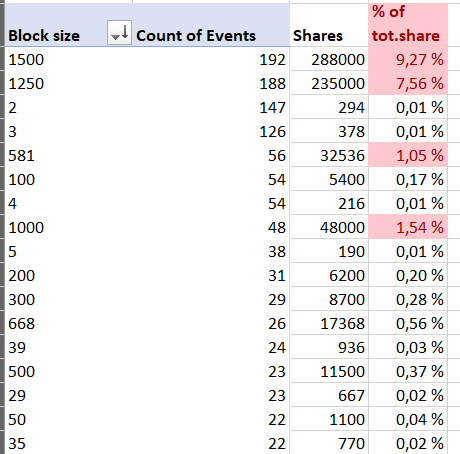
ZTE:n Core carrier equipment divisioona oli flat, eli ei mikään erityinen succee ollut tämäkään kiinalainen Noksun kilpailija. Koko ZTE myy melkein 70% Kiinaan. Hyvähän se on katetta kasvattaa, kun Kiinan valtiovallan kontrolloimat operaattorit antavat kiinalaisille firmoille 97% kaupasta ja korkeammalla hinnalla vs Ericsson / Nokia. Toki artikkeli sanoo että kulujakin trimmattiin
Summa Summarum, ei vaikuta ZTE saavan Kiinan ulkopuolella sitä mitä Huawei sanktiointi jättää muille firmoille. Nokiahan on puhunut saaneensa noin 50% geopoliittisista uusista bisneksistä ja Ericsson sitten loput? Ei Samsungistakaan ole juuri tainnut Verizonia lukuunottamatta juuri kuulua
China’s lesser-known comms vendor has unveiled a 119.6% jump in net income to 4.1 billion yuan (US$630 million), with revenue up 12.4% to RMB53.1 billion ($8.2 billion).
But it remains heavily dependent on the domestic market, which accounted for 68% of total sales.
Sales were flat in its core carrier equipment division, most likely because of the deferred expenditure by Chinese operators.
However, the unit trimmed costs by 10% and improved its gross margin by 6.5%, driven primarily by higher 5G margins, it said.
https://www.lightreading.com/asia/zte-doubles-1h-net-on-5g-and-rebound-in-handsets/d/d-id/771776?
